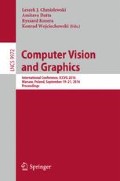Abstract
The most popular method for assessment the endothelial function, called flow-mediated dilation, is based on monitoring how the brachial artery diameter changes in hyperemia state. All of the existing methods that assess FMD are exceedingly time consuming, as they require supervising analysis of the whole video. The presented method fully-automatically analyzes the videos and returns the FMD value using region of interest (ROI) defined by the operator. The main contributions of this paper are: minimizing inter and intra-observer variability; eliminating supervision from the analysis; applying more informative techniques than edge detectors; providing dataset which can be used by other researchers to test their fully-automatic methods.
Access this chapter
Tax calculation will be finalised at checkout
Purchases are for personal use only
References
Bartoli, G., Menegaz, G., Lisi, M., Di Stolfo, G., Dragoni, S., Gori, T.: Model-based analysis of flow-mediated dilation and intima-media thickness. J. Biomed. Imaging 2008, 16–16 (2008)
Bots, M.L., Westerink, J., Rabelink, T.J., de Koning, E.J.: Assessment of FMD of the brachial artery: effects of technical aspects of the FMD measurement on the FMD response. Eur. Heart J. 26(4), 363–368 (2005)
Celermajer, D.S., Sorensen, K., Gooch, V., Sullivan, I., Lloyd, J., Deanfield, J., Spiegelhalter, D., et al.: Non-invasive detection of endothelial dysfunction in children and adults at risk of atherosclerosis. Lancet 340(8828), 1111–1115 (1992)
Corretti, M.C., Anderson, T.J., Benjamin, E.J., Celermajer, D., Charbonneau, F., Creager, M.A., Deanfield, J., Drexler, H., Gerhard-Herman, M., Herrington, D., et al.: Guidelines for the ultrasound assessment of endothelial-dependent flow-mediated vasodilation of the brachial artery: a report of the international brachial artery reactivity task force. J. Am. Coll. Cardiol. 39(2), 257–265 (2002)
Craiem, D., Chironi, G., Gariepy, J., Miranda-Lacet, J., Levenson, J., Simon, A.: New monitoring software for larger clinical application of brachial artery flow-mediated vasodilatation measurements. J. Hypertens. 25(1), 133–140 (2007)
Faita, F., Masi, S., Loukogeorgakis, S., Gemignani, V., Okorie, M., Bianchini, E., Charakida, M., Demi, M., Ghiadoni, L., Deanfield, J.E.: Comparison of two automatic methods for the assessment of brachial artery flow-mediated dilation. J. Hypertens. 29(1), 85–90 (2011)
Flammer, A.J., Anderson, T., Celermajer, D.S., Creager, M.A., Deanfield, J., Ganz, P., Hamburg, N.M., Lüscher, T.F., Shechter, M., Taddei, S., et al.: The assessment of endothelial function from research into clinical practice. Circulation 126(6), 753–767 (2012)
Freund, Y., Schapire, R.E.: A decision-theoretic generalization of on-line learning and an application to boosting. J. Comput. Syst. Sci. 55(1), 119–139 (1997)
Gemignani, V., Faita, F., Ghiadoni, L., Poggianti, E., Demi, M.: A system for real-time measurement of the brachial artery diameter in b-mode ultrasound images. IEEE Trans. Med. Imaging 26(3), 393–404 (2007)
Gryglewski, R.J.: Pharmacology of vascular endothelium. FEBS J. 272(12), 2956–2967 (2005)
Hiltawsky, K., Wiegratz, A., Enderle, M., Ermert, H.: Real-time detection of vessel diameters with ultrasound. echtzeiterkennung von gefäßdurchmessern mit ultraschall. Biomedizinische Technik/Biomedical. Engineering 48(5), 141–146 (2003)
Liang, Q., Wendelhag, I., Wikstrand, J., Gustavsson, T.: A multiscale dynamic programming procedure for boundary detection in ultrasonic artery images. IEEE Trans. Medi. Imaging 19(2), 127–142 (2000)
Seiffert, C., Khoshgoftaar, T.M., Van Hulse, J., Napolitano, A.: Rusboost: A hybrid approach to alleviating class imbalance. IEEE Trans. Syst. Man Cybern. Part A Syst. Hum. 40(1), 185–197 (2010)
Sidhu, J., Newey, V., Nassiri, D., Kaski, J.: A rapid and reproducible on line automated technique to determine endothelial function. Heart 88(3), 289–292 (2002)
Sonka, M., Liang, W., Lauer, R.M.: Automated analysis of brachial ultrasound image sequences: early detection of cardiovascular disease via surrogates of endothelial function. IEEE Trans. Med. Imaging 21(10), 1271–1279 (2002)
Thijssen, D.H., Black, M.A., Pyke, K.E., Padilla, J., Atkinson, G., Harris, R.A., Parker, B., Widlansky, M.E., Tschakovsky, M.E., Green, D.J.: Assessment of flow-mediated dilation in humans: a methodological and physiological guideline. Am. J. Physiol. Heart Circulatory Physiol. 300(1), H2–H12 (2011)
Woodman, R., Playford, D., Watts, G., Cheetham, C., Reed, C., Taylor, R., Puddey, I., Beilin, L., Burke, V., Mori, T., et al.: Improved analysis of brachial artery ultrasound using a novel edge-detection software system. J. Appl. Physiol. 91(2), 929–937 (2001)
Zielinski, B., Roman, A., Drozdz, A., Kowalewska, A., Frolow, M.: A new approach to automatic continuous artery diameter measurement. In: 2014 Federated Conference on Computer Science and Information Systems (FedCSIS), pp. 247–251. IEEE (2014)
Acknowledgement
Dataset used in this paper was acquired from Jagiellonian Centre for Experimental Therapeutics (JCET) at Jagiellonian University in Kraków, Poland. The ultrasound videos were obtained during the study supported by European Union from the resources of the European Regional Development Fund under the Innovative Economy Programme (grant coordinated by JCET-UJ, No POIG. 01.01.02-00-069/09). We gratefully acknowledge the support from Prof. Stefan Chłopicki that were instrumental to carry out this study.
Author information
Authors and Affiliations
Corresponding author
Editor information
Editors and Affiliations
Appendix: Code and dataset
Appendix: Code and dataset
The code of application and dataset used in experiment are publicly available under the following link: www.ii.uj.edu.pl/~zielinsb.
Rights and permissions
Copyright information
© 2016 Springer International Publishing AG
About this paper
Cite this paper
Zieliński, B., Dróżdż, A., Frołow, M. (2016). Fully-Automatic Method for Assessment of Flow-Mediated Dilation. In: Chmielewski, L., Datta, A., Kozera, R., Wojciechowski, K. (eds) Computer Vision and Graphics. ICCVG 2016. Lecture Notes in Computer Science(), vol 9972. Springer, Cham. https://doi.org/10.1007/978-3-319-46418-3_39
Download citation
DOI: https://doi.org/10.1007/978-3-319-46418-3_39
Published:
Publisher Name: Springer, Cham
Print ISBN: 978-3-319-46417-6
Online ISBN: 978-3-319-46418-3
eBook Packages: Computer ScienceComputer Science (R0)

